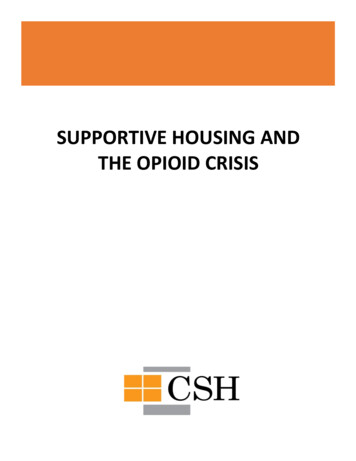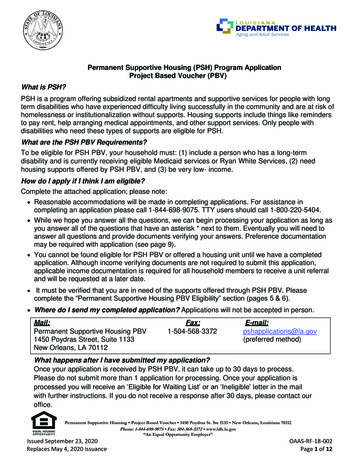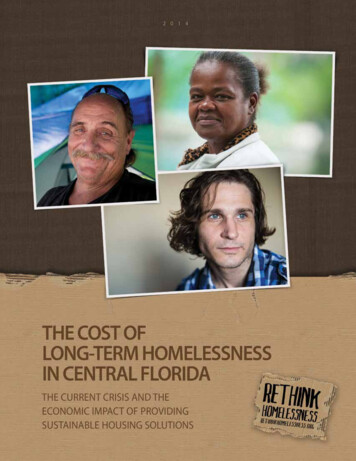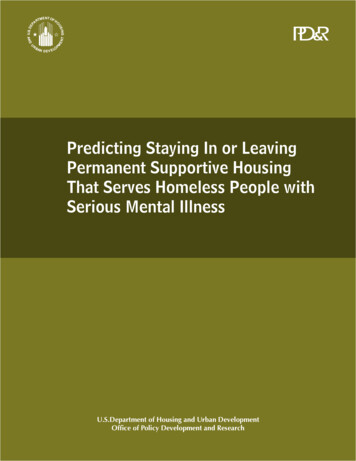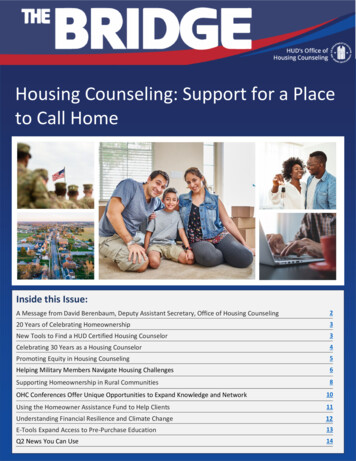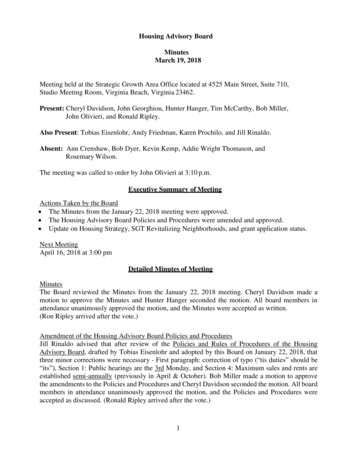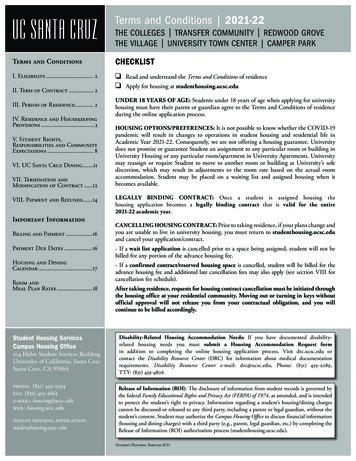
Transcription
September 2003Dear Colleague,Two years ago, the Corporation for Supportive Housing (CSH) convened a group ofproperty management staff from supportive housing sites throughout Northern Californiato engage in an open and frank discussion of the challenges of operating supportivehousing over the long term. Although it is widely acknowledged that “managingsupportive housing is different” than managing affordable and/or market ratehousing, there was not a clear sense that the tools to guide this work existed.In order to answer the question: “Does a manual for operating supportive housingexist?” CSH engaged Gail Gilman and Rashonda McChester to conduct an inventoryand analysis of the existing manuals key supportive housing sponsors in the State ofCalifornia are using. The result of this effort indicated that there was not any onemanual that adequately addresses all of the issues that arise in supportive housingproperty management. Following confirmation by numerous property managers thatcreating a new manual would be of value, CSH got to work!With the assistance and participation of numerous individuals and organizations,CSH has created this “first of its kind” manual, and is pleased to present it for use.(As a manual based on the practices and the laws of California, we encouragesupportive housing sponsors in other States to confer with legal counsel when using thismanual.) Many thanks go to Irma Poe, California CSH Program Officer, who steeredthis entire effort, and to Maryann Leshin, Director, California Program, and to CSH staff,consultants and advisors noted on the following pages for all of their hard work thatwent into the making of this manual.We hope that you will find this manual of value to your organization, and that itsapplication will reap benefits for your supportive housing residents as well. As the fieldof supportive housing matures, we look forward to working with each of you to continuedisseminating best practices and innovative tools to guide the operational side ofsupportive housing. Please do not hesitate to contact us with your comments andquestions at www.csh.org.Sincerely,Carla JavitsPresident1330 Broadway, Suite 601, Oakland, California 94612Phone: (510) 251-1910 Fax: (510) 251-5954
Supportive HousingProperty ManagementOperations ManualSeptember 2003iii
IntroductionIn response to the challenges identified by supportive housing owners throughoutCalifornia, CSH implemented a Property Management Initiative. In September2001 CSH invited representatives of supportive housing projects, including propertyand asset managers, services program directors, tenant advocates andrepresentatives of intermediary organizations, to come together to help us definedeliverables for this Initiative. Representatives from more than 35 agenciesresponded, becoming our Advisors Group (see below). This group recommendedseveral deliverables for our Initiative, including:Identification of a property management operations manual specific to supportivehousing.Over the past several months, we’ve sought out best practices for managing supportivehousing from supportive housing owners throughout California. We then contracted withan experienced supportive housing provider – Community Housing Partnership – tosynthesize these best practices into one Manual.iv
Thank YouWe are very grateful to the following individuals and the organizations theyrepresent for their generous contribution of staff time, organizational resources, andthe “best practices” they shared that are included in this Manual.Advisors Group MembersAlameda Point Collaborative * Chinatown Community Development Corporation * SanFrancisco City Housing/SF * Birute Skurdenis-California Housing Partnership * ConardHouse/SF * Direct Access to Housing/SF Department of Public Health* Cathy Craig-LocalInitiatives Support Corporation * Mercy Services Corp./SF * Oakland Community HousingManagement/Oakland * Resources for Community Development/Berkeley * RubiconPrograms/Contra Costa County * The John Stewart Company/SF * TenderloinNeighborhood Development Corp./SF * Allied Housing Inc./Alameda County * BelindaLyons-Mental Health Association of SF * Citizens Housing Corporation/SFWe are especially grateful to the following individuals and the organizations theyrepresent for their assistance in searching out supportive housing propertymanagement operations manuals, identifying and advising effective use of bestpractices, and helping us develop a Manual intended to help meet the needs ofsupportive housing providers:Gail Gilman, Zeke Weiner, Community Housing Partnership/SFMichael Alvidrez, Skid Row Housing Property Management Company/LAMarc Slutzkin-Chinatown Community Development Corporation/SFKerry Williams-Resources for Community Development, BerkeleyRoshanda McChester, Hamilton Apartments/Mercy Housing/OaklandMichele Magar and Bonnie Milstein, Attorneys at Law / SFWe appreciate former CSH General Counsel Jim Morales’ comment on early drafts.We are also beholden to attorney David Grabill for his assistance; his detailedreview and comment is very much appreciated.Special thanks are extended to CSH CA Program & National Staff:Lisa Appleberry, Ann O’Rielly, Matthew Doherty, Tamar Dorfman,Lauren Hall, Jonathan Hunter, Maryann Leshin, Darin Lounds, Liz Orlin,Scott Owens, Ron Prestridge, Karla TurtleandIrma Poe, Project CoordinatorWe are also indebted to The San Francisco Foundation, The CaliforniaEndowment, and the Department of Housing and Urban Development, Region IXOffice for funding the research, writing and production of this manual.v
MISSION STATEMENT . IXCORE OPERATING PRINCIPLES .XCHAPTER ONE . 1MANAGEMENT PROCEDURES IN SUPPORTIVE HOUSING . 11.0 COORDINATION WITH SUPPORT SERVICES: . 11.1 REASONABLE ACCOMMODATION . 21.2 CONFLICT OF INTEREST. 51.3 UNLAWFUL HARASSMENT . 61.4 THE ELEMENTS OF LEADERSHIP IN SUPPORTIVE HOUSING . 71.5 CHAIN OF COMMAND . 71.6 THE DUTY OFFICER . 81.7 SUPERVISING STAFF . 91.8 RELATIONS WITH TENANTS. 131.9 TENANT SAFETY AND SECURITY . 131.10 RESPONDING TO CRISIS: WHEN TO CONTACT YOUR SUPERVISOR . 151.11 INCIDENT REPORT: FOLLOW-UP . 161.12 TENANT FILE MAINTENANCE AND RECORD KEEPING . 17CHAPTER TWO . 19LEASE ENFORCEMENT, RENT COLLECTION, DELINQUENCY . 19FOLLOW-UP, HOUSING RETENTION, & THE EVICTION PROCESS . 192.0 LEASE ENFORCEMENT . 192.1 COORDINATION WITH SUPPORT SERVICES . 192.2 GUIDELINES FOR RENT COLLECTION . 202.3 PAYMENT PLEDGES . 222.4 RESPONDING TO TENANTS WHO DISPUTE RENT BALANCES . 232.5 THE EVICTION PROCESS. 23CHAPTER THREE . 25SCREENING APPLICANTS & MOVING TENANTS INTO HOUSING . 253.0 WHEN APPLICANTS FOR HOUSING COME TO THE SUPPORTIVE HOUSING SITE. 253.1 REASONABLE ACCOMMODATION . 263.2 THE APPLICANT SCREENING . 283.3 REJECTION CRITERIA IN SUPPORTIVE HOUSING . 313.4 ELIGIBILITY SCREENING . 333.5 ORIENTING TENANTS TO THEIR NEW HOME . 333.6 TENANT FILES . 343.7 HOME HEALTHCARE PROVIDERS . 35vi
3.8 CARE ANIMALS/PETS ON THE PROPERTY . 363.9 UNIT TRANSFERS AFTER MOVE-IN . 36CHAPTER FOUR. 38FRONT DESK AND LOBBY OPERATIONS . 384.0 PROPERTY MANAGEMENT IN A SUPPORTIVE HOUSING ENVIRONMENT. 384.1 INFORMATION . 384.2 CONFIDENTIALITY . 394.3 EMERGENCIES, INJURIES, CRISIS MANAGEMENT . 394.4 VIOLENCE AND THREATS TO HARM . 414.5 CRISIS INTERVENTION . 414.6 INTERACTIONS WITH TENANTS AND VISITORS . 424.7 FRONT DOOR & LOBBY CONTROL . 424.8 IDENTIFICATION FOR VISITORS . 444.9 OVERNIGHT VISITORS . 444.10 UNAUTHORIZED VISITOR LIST & GUIDELINES . 454.11 NO-VISIT LIST . 464.12 INCIDENT REPORTS AND TENANT COMPLAINT FORMS . 474.13 INTERACTING WITH EXTERNAL AGENCIES AND AUTHORITIES . 484.14 CHECK REQUESTS AND CONTRACTING WITH VENDORS . 524.15 WORK ORDERS AND ROUTINE MAINTENANCE. 534.16 ELEVATOR AND OTHER MAINTENANCE EMERGENCIES. 534.17 LOCK-OUTS . 534.18 VIDEO MONITORS . 544.19 TELEPHONE PROTOCOL . 544.20 RADIOS AND TELEVISION SETS . 554.21 LOCK BOX - KEYS . 554.22 ATTENDANCE . 564.23 BREAKS AND BATHROOMS. 564.24 RATE OF PAY - OVERTIME . 56CHAPTER FIVE . 58MOVE-OUT AND UNIT TURNAROUND PROCEDURES . 585.0 THE END OF THE TENANCY . 585.1 MANAGEMENT NEXT STEPS . 585.2 MONITORING THE TURN-AROUND . 595.3 HOUSING QUALITY STANDARDS (HQS) . 59CHAPTER SIX . 61PHYSICAL PLANT: MAINTENANCE, JANITORIAL & PEST CONTROL . 616.0 SUPPORTIVE HOUSING STANDARDS . 616.1 MAINTENANCE AND JANITORIAL WORK IN THE SUPPORTIVE HOUSING SETTING . 61vii
6.2 REASONABLE ACCOMMODATION . 626.3 WORK ORDERS . 626.4 MAJOR BUILDING SYSTEMS . 626.5 UTILITY METERS . 636.6 GRAFFITI REMOVAL . 636.7 DAMAGE BEYOND NORMAL WEAR AND TEAR: CHARGE-BACKS TO TENANTS . 636.8 DAMAGE WITHIN NORMAL WEAR AND TEAR . 646.9 PEST CONTROL . 646.10 JANITORIAL COVERAGE . 656.11 JANITORIAL SAFETY PRECAUTIONS . 656.12 SATELLITE AND ANTENNA INSTALLATION . 666.13 PARKING . 666.14 SIGNS . 67CONCLUSION . 68APPENDIX. 69SAMPLE FORMS . 69viii
Mission StatementThis manual reflects the best practices many supportive housing providers use to manage andoperate quality affordable housing with on-site or accessible supportive services available totenants with special needs. One best practice is to include the housing owner’s mission statementin the property management operations manual. The supportive housing owner’s mission statementusually defines the goals, objectives and outcomes the housing owner and/or its propertymanagement agent seek to achieve as a supportive housing provider. The mission statement alsoserves as an operating guide for operations-management staff. Following is a sample missionstatement.SAMPLE – Supportive Housing Mission StatementWe are committed to owning, and/or management permanently affordable, safe and wellmaintained housing for low and extremely low-income persons, many of who have special needs.We believe that all persons have a right to quality affordable housing. We are committed tohelping people in need, without regard to race, color, religion, sex, national origin, sexualorientation, or disability.We strive to create a supportive housing environment that fosters independence, especially in theareas of housing retention, vocational development and employment, to help break the cycle ofhomelessness experienced by many very low-income and disabled persons. We are committed toworking with tenants to provide a supportive environment with integrated human services,vocational and employment opportunities, accessible social services and tenant-led groups. We arecommitted to working in cooperation with the many public and private agencies serving peoplewith special needs, to ensure that quality housing and supportive services are provided for thebenefit of tenants.It is our goal to build community, and to involve tenants in every aspect of our business, includingtenant involvement in policy-making by participation on governing board(s).Through these efforts, we support the dignity, independence and self-sufficiency of tenants, andrespect the tenants’ right to involvement in their supportive housing community.ix
Core Operating PrinciplesWe also recommend supportive housing owners’ property management manuals clearly sate theircore-operating principles. Following are Core Operating Principles that can help providers achieveefficient and effective management and operation of supportive housing:SAMPLE – Supportive Housing Core Operating PrinciplesWe show respect for all individuals. We believe that all individuals can and want to contribute totheir fullest potential. Differences are valued. We inspire and enable people to achieve highexpectations, standards, and challenging goals. We are honest with employees about their jobperformance.We are strategically focused. We operate under clearly articulated and aligned objectives, withinapplicable laws, guidelines and regulations, and to fulfill our mission. We expect employeeperformance consistent with their job descriptions, and in compliance with applicable laws,guidelines, regulations, goals and objectives. We simply, standardize, and streamline employeetasks whenever possible to achieve stated goals and objectives.We seek to be the best. We strive to be the best in all areas of strategic importance to our mission,goals and objectives. We benchmark performance rigorously against internal and externalobjectives. We learn from both our successes and failures.Personal Mastery. We believe it is the responsibility of all employees to seek to continuallydevelop the skills and abilities necessary for satisfactory job performance and personal andprofessional advancement. We expect and encourage technical mastery and excellence in theperformance of job tasks and in fulfillment of our goals and objectives.Mutual Interdependence. We work together with confidence and trust across functions. We takepride in sharing our best practices and learning from our failures. We build superior relationshipswith all parties, including our tenants, co-workers, suppliers, and internal and external partners.Collaboration With Partners. We work in close collaboration with the support services unit andother internal and external units, to fulfill the goals and objectives stated in our mission statement.We work in tandem in order to implement our supportive housing retention model to the fullestcapacity, and to build community for the benefit of our tenants.x
Chapter OneManagement Procedures in Supportive HousingThis manual is intended as a tool to train supportive housing staff on how to perform propertymanagement tasks in a supportive housing environment. As members of the property managementdepartment, supportive housing staff should be encouraged, and held accountable, to learn and tofollow these policies and procedures, which represent best practices in managing supportivehousing.1.0 Coordination with Support Services:The Core of Supportive Housing OperationsCoordination MeetingThe core mission of supportive housing is to provide quality affordable housing for people withdisabilities who are homeless or at risk of homelessness. On-site and/or easily accessible supportiveservices and resources are available to help eligible persons access and retain quality affordablehousing.Well-managed supportive housing centers on tight coordination and collaboration among the tenanthouseholds, the property management staff and the support services team. This essentialcoordination and collaboration begins with open communication and information flow between thestakeholders, within the bounds of rights to privacy and confidentiality as defined by applicablelaws, rules, guidelines and/or regulations. A best practice for effective staff coordination andcollaboration is regularly scheduled site coordination meetings between building management staffand support services staff. Weekly meetings are encouraged.The encouraged supportive housing site coordination meetings usually address the following maintopics: Delinquent rent - tenants whose housing is in jeopardy due to failure to pay rent orcomply with authorized payment plans.On-going behavior in violation of the leasing agreement/house rules and/or behaviorthat jeopardizes the right to quiet enjoyment and safety of other tenants.Individual and community activities intended to and/or resulting in communitybuilding within the supportive housing site and/or the surrounding community.Regularly scheduled site coordination meetings are a format that can help the building managementstaff and the support service staffs determine whether a tenant needs assistance to stabilize housing.Staff can discuss the availability of appropriate resources and services, develop intervention and/orsupport strategies, and/or assess the result(s) of interventions, activities and/or events.1
Collaboration MeetingsIn addition to site coordination meetings, many supportive housing owners schedule collaborationmeetings every month. At this meeting, building management staff, support services staff, andtenant representatives meet to develop strategies to address incidents that jeopardize the safety andsecurity of tenants or employees, and to plan activities, events, services and/or resources thatempower tenants and help build community.Staff and tenant representatives use collaboration meetings to work together to build communitywithin the supportive housing site(s), frequently by planning and presenting activities that offertenants opportunities for recreation, socialization and personal empowerment.Note: Support services representatives who acquire confidential information about tenants must becareful not to disclose protected information during a site coordination or collaboration meeting,unless the tenant has consented to the disclosure. Authorization is usually obtained by requestingthat the tenant sign a Consent of Release of Information form defining what information is to bereleased: to whom, for what purpose, for what period of time.1.1 Reasonable AccommodationSupportive housing serves persons with special needs, such as mental and/or physical disabilities,histories of chronic use of alcohol and drugs and/or who may be living with disabling healthconditions. Supportive housing helps persons with special needs access and retain qualityaffordable housing.(*) “Federal law prohibits discrimination against persons with disabilities and requires alllandlords to provide reasonable accommodation for tenants’ disabilities. The Fair HousingAct, as amended in 1988, prohibits all housing providers from discriminating against peoplewith disabilities, including psychiatric disabilities. A housing provider violates the FairHousing Act when it ‘refuses to make reasonable accommodations in rules, policies, practicesor services, when such accommodations may be necessary to afford such person equalopportunity to use and enjoy a dwelling ’ unless such accommodation will fundamentallyalter the provider’s program or cause an undue financial or administrative burden.Similarly, Section 504 of the Rehabilitation Act of 1973 prohibits all federally funded entitiesfrom discriminating against any otherwise qualified individual ‘solely on the basis of his orher handicap,’ and includes an implicit requirement to provide reasonable accommodation.”Supportive housing owners and employers are required by law to respond to requests for reasonableaccommodations in all aspects of their operations to assist persons with disabilities succeed inaccessing and retaining housing.Persons living with disabilities are legally entitled to accommodation if they need it in order to havethe full use and enjoyment of their housing. The housing provider has a duty to make reasonableaccommodation to each person residing or working at the housing site. This duty extends to allaspects of the housing operation including but not limited to (each item is followed by an example):2
The intake and screening process. If an applicant or tenant is not able to provide thedocumentation required of applicants to meet eligibility criteria, the provider couldmake reasonable accommodation with respect to this requirement. The provider couldallow the applicant additional time to gather the documentation, or request thedocumentation directly from the source. Occupancy. Where the provider has a “no pets” rule. When a tenant with a disabilityrequests permission to have a small pet (a cat, dog, fish or bird) and his/her healthcareprovider verifies that the animal, fish or bird will serve a therapeutic function for thetenant or applicant, the supportive housing provider should be willing to waive the “nopets” rule as a reasonable accommodation to the tenant. But “reasonable” also haslimits. The pet should not be an animal that repeatedly disturbs other tenants or placesother tenants in fear. The tenant has to be able to feed and care for the pet. Daily interactions with tenants. A tenant with a mental disability occasionally gets intoverbal altercation with other tenants, apparently because of problems related to his/herprescribed medication. While these altercations might be grounds for evicting tenantswho do not have a disability, the provider has a legal duty to “go the extra mile” beforeevicting this tenant, as a reasonable accommodation. This may involve setting up aconference with the tenant’s healthcare provider to discuss the problem and to exploreways to prevent future altercations. If the tenant and the health care provider are madeaware of the problematical behavior, it can often be remedied through medical ortherapeutic intervention. Eviction should be considered a last resort in these situations.If a tenant physically attacks other tenants, or puts them in fear of serious bodily harm,the provider is not required to attempt reasonable accommodation before takingappropriate steps to protect other tenants and staff. Management. Property management may have a rule requiring payment of rent on orbefore the fifth day of each month. A tenant who is habitually late paying rent can createbookkeeping problems for the provider. If, however, the habitually late payment isrelated to the tenant’s disability, the provider has a duty to make reasonableaccommodation. This accommodation could be accomplished by allowing some leewayin payment of rent. This does not mean that the provider should waive the rule entirely.It means that the provider should be flexible and ”reasonably accommodating” to thetenant. Maintenance. A tenant occasionally scrapes the walls with his/her wheelchair. Unlessthis
in the property management operations manual. The supportive housing owner's mission statement usually defines the goals, objectives and outcomes the housing owner and/or its property management agent seek to achieve as a supportive housing provider. The mission statement also serves as an operating guide for operations-management staff.

